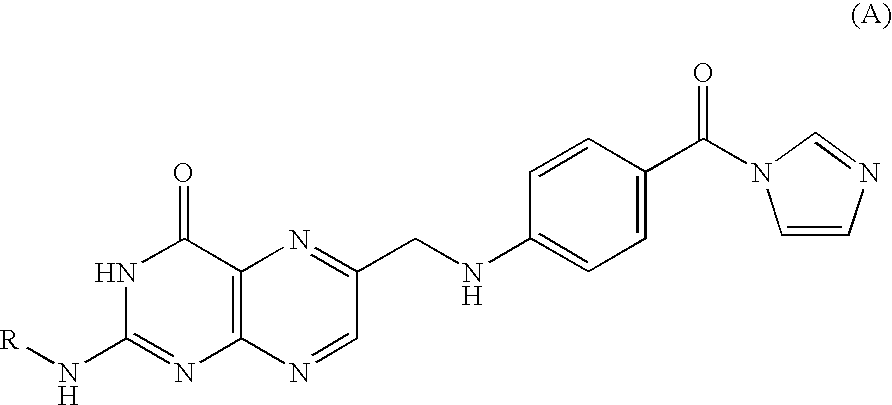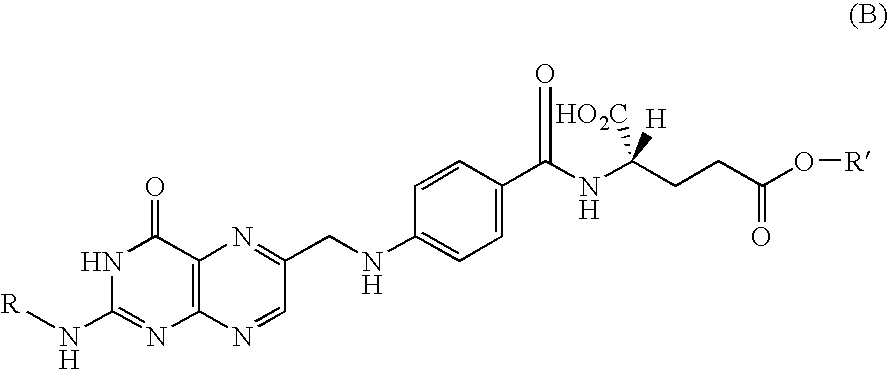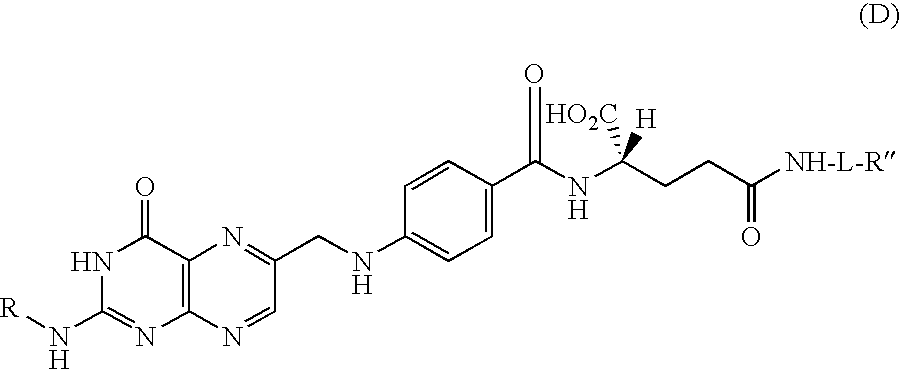Process for producing folic acid derivatives
a technology of folic acid and derivatives, which is applied in the direction of biocide, group 3/13 element organic compounds, drug compositions, etc., can solve the problems of difficult purification of the aimed compound alone as contained in the mixture, limited pharmacotherapy, and many problems of cancer chemotherapy, so as to achieve easy binding, high efficiency, and the effect of increasing the effect of the intended medicinal
- Summary
- Abstract
- Description
- Claims
- Application Information
AI Technical Summary
Benefits of technology
Problems solved by technology
Method used
Image
Examples
referential example
(REFERENTIAL EXAMPLE)
Synthesis of 1-[2-N-[2-(trimethylsilyl)ethoxycarbonyl]pteroyl]-imidazole
[0046] To a mixture of 3.0 g of pteroic acid and 5.35 mL of triethylamine (TEA), 6.24 g of CDI as dissolved in 50 mL of DMSO was added and reacted at room temperature for 3.5 hours. To the reaction solution 2-(trimethylsilyl)ethanol (9.63 mL) was added, followed by further 5 hours' reaction at room temperature. The reaction solution was added dropwise into water (10 mL)-acetic acid (0.32 mL) and dimethyl ether (6.4 mL), vigorously stirred for a few minutes, and recovered as solid by suction filtration. The solid product was purified by column chromatography (silica gel column: eluent; 10% methanol in chloroform) and dried under reduced pressure to finally give 2.67 g (yield=54.8%) of aimed compound.
production example 2 (working example)
Synthesis of γ-methyl 2-N-[2-(trimethylsilyl)ethoxycarbonyl]-folate
[0047] Into 0.477 g (2.96 mmols) of γ-methyl glutamate, a solution of 1.0 g (1.97 mmols) of 1-[2-N-[2-(trimethylsilyl)ethoxycarbonyl]-pteroyl]imidazole and 0.7 mL (4.8 mmols) of MTBD in 10 mL of DMSO was dropped and reacted at room temperature for 21 hours. As the purification treatment, the reaction solution was added dropwise to aqueous acetic acid (1M, 30 mL)-methanol (15 mL) and CHCl3 (30 mL), and the organic layer was washed with acetic acid (1M)-methanol (1:1, 20 mL) and water-methanol (2:1, 30 mL, twice), then dehydrated over Na2SO4, filtered, and the solvent was distilled off. Finally the residue was washed with CHCl3-diethyl ether to give 1.05 g (yield: 88.5%) of the aimed compound. This compound was identified to be the aimed compound by 1HNMR measurement (one of the peaks (7.1 ppm) attributable to imidazole group disappeared completely and newly a peak (3.6 ppm) attributable to the methyl glutamate group ...
production example 3 (working example)
Synthesis of folic acid γ-hydradide
[0048]γ-Methyl 2-N-[2-(trimethylsilyl)ethoxycarbonyl]folate (0.21 g) was dissolved in 10 mL of anhydrous hydrazine and reacted at 50° C. for 3 hours. After termination of the reaction, the solvent was removed under reduced pressure, and the residue was re-dissolved in 10 mL of aqueous hydrochloric acid (pH 1.0), stirred for an hour at room temperature, neutralized with aqueous NaOH solution and then lyophilized. The lyophilized product was re-dissolved in pure water and centrifuged twice to be desalted. Finally, the aimed compound was lyophilized and recovered as a yellow powder.
PUM
| Property | Measurement | Unit |
|---|---|---|
| pH | aaaaa | aaaaa |
| solubility | aaaaa | aaaaa |
| polar | aaaaa | aaaaa |
Abstract
Description
Claims
Application Information
 Login to View More
Login to View More - R&D
- Intellectual Property
- Life Sciences
- Materials
- Tech Scout
- Unparalleled Data Quality
- Higher Quality Content
- 60% Fewer Hallucinations
Browse by: Latest US Patents, China's latest patents, Technical Efficacy Thesaurus, Application Domain, Technology Topic, Popular Technical Reports.
© 2025 PatSnap. All rights reserved.Legal|Privacy policy|Modern Slavery Act Transparency Statement|Sitemap|About US| Contact US: help@patsnap.com



